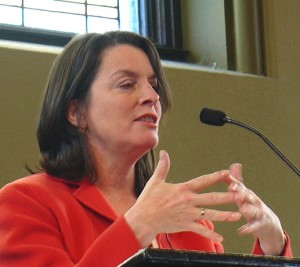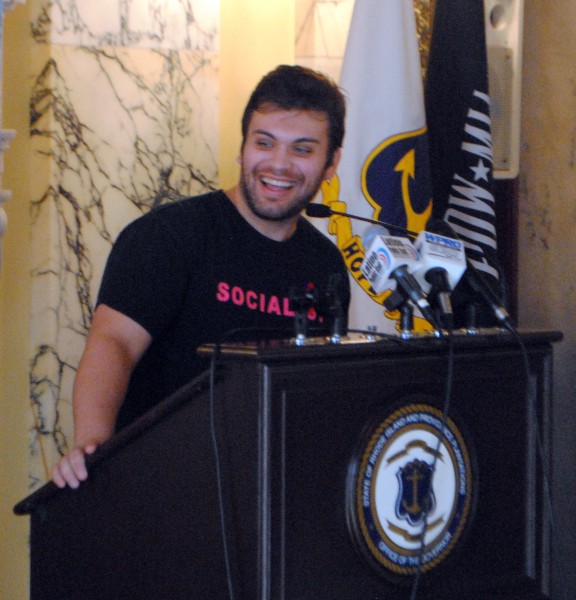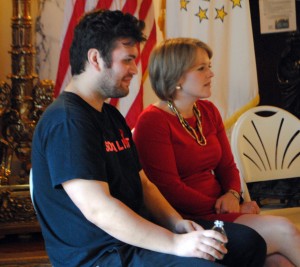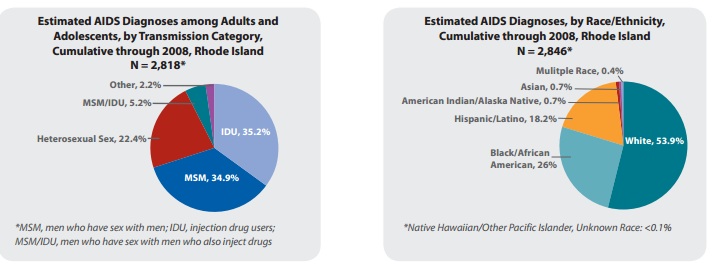 A recent Gallup poll revealed that Rhode Island has the lowest uninsured rate in the country, at 2.7 percent, as well as one of five states that saw its uninsured rate decline by 10 points or more. But, how did that happen? Anya Wallack, director of HealthSourceRI, was able to provide some answers.
A recent Gallup poll revealed that Rhode Island has the lowest uninsured rate in the country, at 2.7 percent, as well as one of five states that saw its uninsured rate decline by 10 points or more. But, how did that happen? Anya Wallack, director of HealthSourceRI, was able to provide some answers.
“You come to HealthSource, and right there, you can very easily sign up for coverage regardless of your income,” she said. “We’ve developed an infrastructure that’s really designed for this unified approach.”
Wallack explained Rhode Island decided to create its own exchange because it presented “significant advantages, in terms of local control and customer service.” With a state based exchange, rather than a federal one, they could better tailor their services to the needs of Rhode Islanders.
HealthSourceRI uses what she called a “one door policy,” meaning that customers could come in and not only apply for health insurance, but check to see if they were eligible for Medicaid and other benefits. This is where much of the exchange’s success comes from, since this is a policy only a few states have adopted.
Wallack said that making customers jump through hoops only serves to make things more confusing, and they miss out on important information because of it. Right now, Wallack and her team are expanding their open door policy, and making it possible for customers to begin to apply for other assistance programs like TANF or SNAP.
“When we’re done building our system, you’ll be able to sign up for those with one stop shopping,” she said.
Wallack added that there are a number of ways that customers can use this one stop shopping, that all services are provided online, over the phone, or in person. Face-to-face assistance is also provided right in the community health centers, so customers can sign up for insurance right in their hometown. HealthSourceRI also has enrollment events during the open enrollment period, which is from Nov. 1 to the end of January each year. During open enrollment, a customer can renew, reenroll, or sign up for coverage, or just change their plan. There are two other types of enrollments as well- special enrollment and Medicaid coverage. Special enrollment occurs when a customer’s circumstances change throughout the year and they need to change their plan, and Medicaid coverage happens throughout the year to see if a customer is eligible for Medicaid.
“We try to find any avenue where we can come into contact with people who may be looking for coverage,” Wallack said concerning their community accessibility.
This level of accessibility has worked for the exchange, proved not only by the Gallup poll but the hard numbers that HealthSource has collected so far for this year. In 2015, they have enrolled 32,554 individuals as of July 31. Most people who enrolled were age 55 and over, sitting at 29 percent. 53 percent of enrollees were female, while 47 percent were male. More than half of the enrollees – 59 percent – were eligible for financial assistance in the form of an advanced premium tax credit and cost-sharing reductions. These numbers show an upward trend from last year, with over 7,000 more enrollees. Small businesses are signing up through HealthSource as well, with 542 employers enrolled in 2015, compared to the 381 from 2014.
The Gallup poll found that states that set up their own exchange and expanded Medicaid saw the biggest drop in their uninsured rate, something that the Ocean State has been doing since day one. According to Wallack, as long as they continue with this, Rhode Island can serve as a model for other states and their healthcare exchanges, especially as HealthSourceRI moves forward. Within the next month, HealthSource will be releasing its own survey, which will give more accurate results than the Gallup one, because it will only look at Rhode Island. But, the national survey still shows a trend, and that Rhode Island is headed in the right direction.
“What I take from this, is that those policy decisions, as well as our decisions to take a coordinated approach, was successful for us,” Wallack said.
HealthSource’s next step is to find those last remaining uninsured individuals, and understand why they’re uninsured, as well as work with employers to make sure that they are able to retain coverage. Now, their job is to help control healthcare cost growth, provide support for small business, and provide affordable choices for everyone, especially that last 2.7 percent.
]]>National data from KIDS COUNT, an organization that helps to mold better futures for children who are at risk of experiencing poor education, health, and socioeconomic factors, ranked Rhode Island as the 31st state in the nation for child well being. Rhode Island was also the lowest ranked among New England states, partially due to increases in the percentage of children living in poverty.

The Cabinet has three specific goals: to create a five-year strategic plan that will improve outcomes for children and their families; to establish policies and performance metrics for each state department; and measure progress on collaborative initiatives for children across these departments.
“All kids deserve to make it in Rhode Island,” Raimondo said. “As a parent, I am focused on giving my kids every opportunity to succeed. We must provide every Rhode Island kid with that same opportunity. When we invest in our kids, we’re investing in our future, workforce and economy. Working together, across government and with the community, we can set our families and our state on a path for a healthy, stable future.”
Raimondo appointed Health and Human Services Secretary Elizabeth Roberts as the Cabinet’s chair. As the chair, she will guide the Cabinet in their efforts to improve children’s well being across the state.
“Every child deserves an opportunity for a safe, healthy, successful, and bright future,” Roberts said. “It is our responsibility as public officials- and as caretakers of the state they will inherit- to protect that opportunity.”
During their meeting, the Cabinet spoke on several topics, such as a new agency-wide policy on human trafficking, child welfare, early childhood education, and strengthening collaboration between the Department of Children, Youth, and Families (DCYF), and the Department of Behavioral Healthcare, Developmental Disabilities and Hospitals (BHDDH).
The Cabinet was established in 1991, but saw several changes during the 2015 legislative session. The statue that created the group was amended to better integrate state services across departments and agencies, as well as adding the Secretary of Health and Human Services, the Child Advocate, and the Governor as members.
]]>
I’m a healthcare worker, Queer activist, and consider myself to be pretty well-informed and connected and yet if you had asked me about PrEP as recently as September, I would have wondered what you are talking about. I’m up here today because I feel that the word PrEP needs to be on the lips of every sexually active person and the people they love.
PrEP which stands for Pre-Exposure Prophylaxis is a once a day dose of an anti-retrovirus drug called, Truvada; which is also used for people who are HIV Positive to help keep viral loads low, but in people who are negative, if exposed to HIV, kills the virus before it has the chance to infect you. Numerous studies have shown it to be pretty darn effective.
Being newly single, and sexually active, this naturally piqued my interest; if a one a day pill can help prevent an unwanted condition, why wouldn’t I be on it?
But for good measure, I took to social media to see if anyone in my extended networks had any thoughts or experiences with it. The results were somewhat unsurprising, but worth breaking down:
Two people reached out to me privately to tell me their stories, which were well-received and appreciated, but I wondered why they didn’t feel safe to say publically they were PrEP users. Until I saw some of the other public responses (most of which were positive), but there were a strong current of people who were telling me that I weren’t being “sleazy” I wouldn’t have to worry about this or that they felt that this pill will encourage “bad” behavior.

This line of thought is nothing new…54 years after the Birth-control Pill hit the market and 41 years after safe and legal abortion was won, people are still saying that contraception will encourage “bad” behavior.
Well I’ve got news for them. “Bad” behavior does not need encouragement. At all. And furthermore, there is nothing bad, dirty, or shameful about sex. We owe it to ourselves, our partners, and the people we love to first and foremost, enjoy ourselves, but also to do everything we can to protect ourselves and other.
We as a society need to come to grips with the fact that sex-positive and queer-inclusive sex education not being a part of our public school curriculum is nothing short of a public health crisis; creating a layer of young people with lots of misinformation and questions who are afraid to seek out answers for fear of judgment. This is dangerous. Silence, in this case, literally equals death.
I, along with my Doctor, Dr, Chan, did decide that going on PrEP was the right decision for the type of life I lead. I was very fortunate to thus far not experience and of the side effects (nausea, vomiting etc.). And if you’re wondering, it didn’t encourage and more or less “bad” behavior.
To conclude, I would be remiss if I didn’t discuss how equally important access to this drug is to it’s availability. I am lucky in that I have a good job with good health insurance, so access to PrEP was no issue for me. But there are so many people in vulnerable demographics (I think of sex-workers and IV drug users especially) may not be as lucky and cannot afford to pay the over $1500 out-of-pocket cost of a monthly supply of Truvada. PrEP has the potential to make new HIV infections a thing of the past, but it cannot do that if no one’s heard of it and people who need it the most cannot access it.
These are the facts, but our challenge as healthcare providers, law-makers, activists, and people who want to see a world without HIV/AIDS is to overcome them. We have come so far already; research in tandem with activism has taken HIV for a death sentence to a chronic, but mostly manageable condition, and now we have the capability to prevent it in the first place. We need to be screaming about this from rooftops, flyering every gay bar, I also liked Dr. Nunn’s idea about using sites like grindr and scruff as tools for outreach, and also making the phrase “ask your doctor about PrEP” as recognizable a slogan as “get tested” and “know your status” is now!
]]>According to the Center for Disease Control an estimated 19 million people will become infected with an STD this year adding to the millions of years past. In fact out of those 19 million people half of them will be under the age of 25 which shows that more needs to be done to educate young people in the state.
Rhode Island is doing well though according to nation wide statistics. With RI being ranked 37th for chlamydia rates and 42nd for gonorrhea but more needs to be done. As of 2008 chlamydia infections were (313.6 per 100,000 persons) and gonorrhea infections were (29 per 100,000 persons) with women having a 2.5 higher percentage of infection than men. Other statistics like herpes and HPV often go undocumented so the numbers for those are skewed. HIV statistics below.

Image credit: Your STD Help
More can and needs to be done here in RI and across the country to start a decline in these numbers and the two greatest weapons we have are testing and proper education. While RI sex ed classes are satisfactory they could be much more effective. Here’s an excerpt from the NCSSE:
Rhode Island schools are required to provide “accurate information and instruction” on sexuality, HIV, and sexually transmitted diseases (STDs). Schools must also teach “the responsibilities of family membership and adulthood, including issues related to reproduction, abstinence, dating, marriage, and parenthood, as well as information about sexually transmitted diseases, sexuality and lifestyles.” These classes must stress abstinence.
Notice the pushing for abstinence. That should be an important issue to discuss but so should proper condom usage which isn’t mentioned. By going after the root of the problem we can change these statistics for the better in a short period of time we just need to do it.
Without more proper education and routine yearly testing things could easily become worse and we can do better than this.
So this April, and the rest of the year for that matter, lets get this out into the open and make Rhode Island the 50th state in the country for STD statistics.
]]>